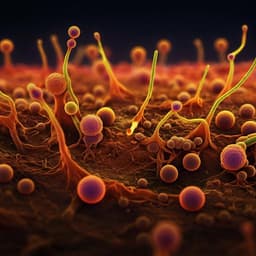
Biology
Non-additive microbial community responses to environmental complexity
A. R. Pacheco, M. L. Osborne, et al.
Discover how environmental complexity influences microbial community dynamics in groundbreaking research conducted by Alan R. Pacheco, Melisa L. Osborne, and Daniel Segrè. This study reveals surprising insights into growth yield and biodiversity that could reshape our understanding of microbial ecosystems.
Playback language: English
Introduction
Microbial communities are fundamental to numerous biological processes, from nutrient cycling to human health. While the impact of individual nutrients on community properties is increasingly understood, the effect of environmental nutrient complexity (the number of different nutrients) remains poorly understood. This relationship is crucial for comprehending how environmental factors influence natural microbial ecosystems, which are exposed to diverse nutrient sources, as well as how diet impacts microbiome structure and function. Studies on natural ecosystems and synthetic microcosms offer conflicting results on how environmental complexity modulates growth yields and taxonomic diversity, underscoring the need for further investigation. An additional key question is the extent to which different nutrient compositions lead to predictable community states versus stochastically driven outcomes. Previous research has demonstrated a combination of deterministic and stochastic processes in community assembly, and the understanding of these patterns' impacts on synthetic consortia cultured in increasingly complex nutrient environments is needed. Classical ecological theories suggest greater biodiversity in more nutrient-rich environments, but factors like organism-specific resource use, niche overlap, and interspecies interactions can cause significant deviations from this expectation. The concept of epistasis, which quantifies the non-linear behavior of biological systems, can be extended to define epistasis between environments, allowing for a quantification of the non-additive effects of nutrient combinations on community properties.
Literature Review
Existing research on the influence of environmental complexity on microbial communities is varied and sometimes contradictory. Studies investigating the effects of dietary nutrient diversity on gut microbiome composition have yielded significant results, showing strong dependencies between nutrient diversity and community composition. However, results from both natural ecosystems and synthetic microcosms have shown conflicting results regarding the relationship between environmental complexity and community growth yields and taxonomic diversity. These discrepancies highlight the gaps in our understanding and hinder efforts to engineer microbiomes for specific functions. While competitive exclusion and niche partitioning theories suggest a positive relationship between nutrient diversity and biodiversity, the role of organism-specific resource utilization, niche overlap, and interspecies interactions significantly influences the outcome. Previous theoretical frameworks, including consumer resource models (CRMs), have been used to study similar questions, but a comprehensive and systematic experimental investigation with a focus on non-additive effects remains lacking.
Methodology
The study employed a hierarchical experimental design to assess the impact of environmental complexity on synthetic microbial communities. Thirteen bacterial species were selected, chosen to maximize taxonomic variability and represent diverse metabolic strategies. Thirty-two carbon sources were selected based on their ability to support the growth of the selected organisms. Synthetic microbial communities were created by combining the 13 organisms at equal ratios. These were then inoculated into minimal media containing various combinations of up to 32 carbon sources. The experimental design involved hierarchical combinations of carbon sources (Fig. 1d) allowing direct comparison of community phenotypes in complex environments to simpler ones containing the same sources. Growth yield was determined by measuring the difference between initial and maximum biomass. The endpoint taxonomic composition was determined using 16S amplicon sequencing. Consumer resource models (CRMs), which predict community growth yields and composition based on species-specific resource utilization preferences (Fig. 1e), were used to generate expectations for community behavior across different environmental complexities and to compare against the experimental results. Epistasis metrics (Eqs. 1-3) were formulated to quantify the non-additivity of community growth yield and diversity. Three communities with 3, 4, and 13 species were studied and compared against corresponding CRM simulations. The CRMs included parameters representing organism-specific resource utilization, niche overlap, and metabolic interactions. The models were calibrated using experimental data from monoculture growth and community composition. The experimental results and the model predictions were then compared to assess whether the growth yield and taxonomic diversity changes in a additive or non-additive manner across different levels of environmental complexity. Statistical methods including paired one-sided t-tests were employed to determine the statistical significance of the observed differences. Hierarchical clustering analysis was used to map environments to taxonomic compositions and explore non-intuitive relationships between environmental composition and community structure.
Key Findings
The study's main findings include: 1. **Growth Yield Scaling:** The 13-species community showed an additive relationship between growth yield and environmental complexity, consistent with CRM predictions. However, smaller communities (3 and 4 species) showed non-additive increases in yield with increasing complexity. The epistasis metric *E*<sub>Y</sub>, quantifying deviations from additivity, confirmed this pattern (Fig. 2d). This difference is attributed to the broader metabolic capabilities of organisms in the larger community, ensuring at least one organism can utilize available carbon sources even in simpler conditions. In contrast, smaller communities with more limited metabolic capabilities showed minimal growth in simpler conditions. 2. **Taxonomic Diversity:** Analysis of the 13-species community showed that environmental complexity didn't cause a statistically significant increase in species richness (*S*) or Shannon entropy (*H*) (Fig. 3c,d). Negative epistasis dominated, demonstrating that combining resources often resulted in lower diversity than expected (Fig. 3f,g). Four distinct patterns were observed in combining environments: I. appearance of new organisms, II. presence of organisms from both original environments, III. dominance of organisms from the lowest-diversity environment, and IV. more complex patterns of diversity loss. Type III, representing complete buffering epistasis, was the most prevalent. 3. **Model Predictions:** CRMs successfully reproduced the observed patterns. Models incorporating varied resource utilization capabilities (reflecting generalists and specialists) and higher niche overlap showed reduced diversity compared to models with uniform resource use (Fig. 3e). These results suggest that reduced taxonomic diversity is a result of competition in communities with varying metabolic capabilities and high niche overlap. Increasing niche overlap was negatively associated with taxonomic diversity. Metabolic cross-feeding might slightly mitigate diversity loss. In summary, while the 13-species community showed an additive relationship for growth yield, smaller communities and the taxonomic diversity of the 13-species community displayed non-additive responses influenced by organism-specific metabolic capabilities and the degree of niche overlap.
Discussion
This study demonstrates that the response of microbial communities to environmental complexity is not simply additive. The additive response of growth yield in the larger community highlights the importance of community-level effects in utilizing diverse resources efficiently. The non-additive increase in smaller communities and the consistently negative epistasis for diversity show that environmental complexity alone cannot guarantee increased diversity. The success of the consumer resource models in capturing these trends emphasizes the critical role of species-specific metabolic characteristics and their interactions in shaping community dynamics. The prevalence of negative epistasis in diversity highlights the competitive dynamics within these communities, where the most competitive organisms tend to dominate even in complex environments. The concept of epistasis provides a powerful framework to quantify non-linearity, with the potential for future refinement based on alternative definitions for expected values. The study's findings have implications for designing and controlling synthetic microbial ecosystems and improving multiscale models of communities in complex environments.
Conclusion
This study provides novel insights into the non-additive responses of microbial communities to environmental complexity. The results reveal the importance of community-level metabolic capabilities and niche overlap in determining growth yield and diversity. The additive relationship observed in the larger community underscores the potential for efficient resource use in diverse communities. The negative epistasis observed in taxonomic diversity highlights the limitations of assuming a simple positive relationship between complexity and diversity. Future research could explore the impact of varying dilution rates, different molecular currencies, and sequential versus simultaneous resource utilization to further refine the understanding of these complex interactions.
Limitations
The study used a simplified model system with a limited number of species and carbon sources. The chosen organisms may not be fully representative of natural microbial communities in terms of their metabolic capabilities. Furthermore, the laboratory environment doesn't perfectly mirror the complexities and dynamic changes of natural ecosystems. The study's findings may not be generalizable to all microbial communities in all environments. Additional research exploring a wider range of species, resource types, and environmental conditions is necessary to improve the robustness and scope of these findings.
Related Publications
Explore these studies to deepen your understanding of the subject.







